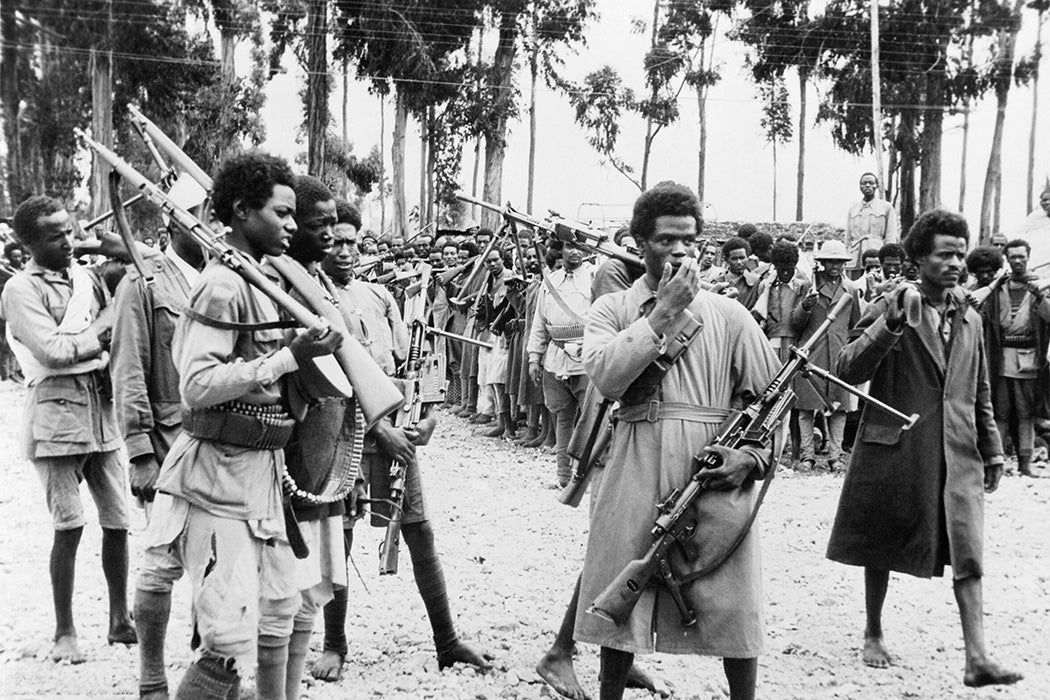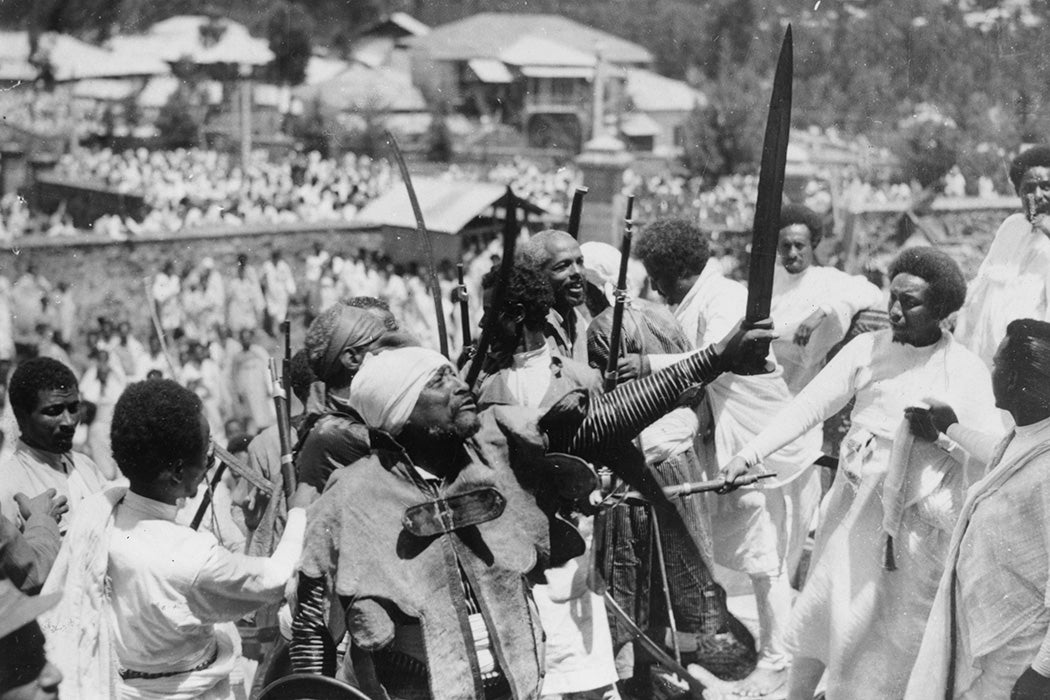In 1932, Mittie Maude Lena Gordon established the Peace Movement of Ethiopia, a black nationalist organization that amassed approximately 300,000 supporters to demand the repatriation of black Americans to Africa. At the time, Ethiopia was not merely a landlocked country in East Africa; it was an independent black nation that symbolized, to many, a kind of providence, both political and divine. It was a symbol of the right to self-determination among black people all across the diaspora.
Three years later, in 1935, Mussolini’s army advanced on a defenseless Ethiopia, beginning a brutal occupation. Mussonlini experimented with new weaponry there, including chemical weapons like mustard gas. As the Ghanaian lawyer S.K.B Asante has demonstrated, Black people around the world, from illiterate West African villagers to working-class women in Harlem, rose up in anger against the Italian assault. The defense of Ethiopia bound them all together. On the surface, the reason was quite clear, and indeed even in the 1921 Pan-African Congress, the African American scholar and activist W.E.B. Du Bois had predicted that “the independence of Abyssinia, Liberia, Haiti and San Domingo” was a necessary precondition for cordial relations across the global color line. But the roots of the international campaign against the invasion run far deeper.
Weekly Newsletter
Mussolini’s invasion of Ethiopia seemed to be a betrayal. Alongside Haiti and Liberia, Ethiopia was one of the few black countries to maintain its independence in a world where the descendants of slaves were still under colonial rule in the Caribbean and facing systemic discrimination in the United States and Latin America. When Africa was carved up and divided between various European powers during the age of high imperialism, Ethiopia was only one of two countries in Africa to maintain its independence. The other was Liberia, but Liberia struggled under the economic and political influence of one U.S. corporation: the Firestone Natural Rubber Company.
Anger toward the Italian occupation engulfed the world. In Trinidad, longshoremen boycotted Italian ships and refused to help unload them. After a proposition by the Hindu trade unionist Adrian Rienzi, Blacks and Asians also constructed a shared anti-war platform in defense of Ethiopia. It was, after all, Ethiopia that successfully defeated the first Italian invasion attempt, at the Battle of Adwa, in 1896. Italian revenge, as the invasion was perceived, would do much to dampen the morale of the global anti-colonial movement, which saw Ethiopia as inspiration for Africa and Asia.
In the small islands of Saint Vincent and Saint Kitts, in 1935, riots took place. And in Saint Lucia, a local chapter of the International Friends of Ethiopia wrote a motion condemning the British embargo on arms to Ethiopia. In Jamaica, parents pulled their children out of schools after unfounded rumors proliferated claiming Italians had been sent to poison them. In the U.S., the Harlem Communist Party, under the leadership of James Ford—who would later become the first black man to run on a presidential ticket—managed to organize a protest in New York that brought 100,000 to march against the war. Later, Ford would volunteer on the side of the republicans and anti-fascists who were waging a war against General Franco (Italy’s ally) in Spain. He declared: “This ain’t Ethiopia, but it’ll do.”
British colonial authorities and members of the U.S. government exhibited a fit of panic at this new international race consciousness, and one could not blame them. A flurry of telegrams had been exchanged by world powers, particularly colonial officials. One colonial officer in Uganda, Hesketh Bell, reflected that if “a distant West Indian island, remembering their African ancestry, should appear to feel so deeply this attack by a white power on the only remaining negro nation,” then it was clear a black internationalism would emerge “among the teeming population of our vast African territories.” A black international, he declared, “would be a misfortune of the first magnitude.” Another colonial official was agitated by the “bellicose sons of Ham in Jamaica, so anxious to serve two masters.”

This statement, even if it was made contemptuously, captured the place of Ethiopia in black thought. The Black diaspora’s general admiration toward Ethiopia had its roots not only in an anti-colonial political affinity, but in a theological one as well (although the two forces can’t be separated), which often claimed that blacks were the sons of Ham from the land of Kush, waiting for a divine reckoning.
During the 1890s, various churches that called themselves Ethiopian emerged in South Africa, particularly in the Transvaal region. They propagated a prophetic variant of Christianity that stated, among other things, that Africa would belong to Africans, that blacks would be liberated through divine justice, and that Black churches should maintain their independence.
But the earliest allusions to “Ethiopianism” preceded the first Italo-Ethiopian war. Principally, Ethiopianism was said to be derived from a biblical prophecy, in Psalm 68:31: “Princes shall come out of Egypt; Ethiopia shall soon stretch out her hands unto God.” As Black pastors contested scripture against dominant interpretations, which justified slavery, the verse itself took up millenarian significance. Central to Ethiopianism was an idea that God would avenge the suffering that black people had faced—and that Europeans would face a reckoning, should they not change.
It is difficult to trace when these churches began to emerge. The black poet Phillis Wheatley often expressed herself in both her religious and literary work as an “Ethiop.” When addressing deist and atheist audiences, she would introduce herself as an Ethiopian delivering the word of God against those who had rejected it. In the 1770s, furthermore, the African American preacher George Liele founded an Ethiopian congregation in the slave quarters of Jamaica. As far back as 1808, a black Episcopalian minister named Peter Williams celebrated the British abolition of the slave trade in his New York Church with the prayer, “may the time speedily commence when Ethiopia shall stretch forth Her hands.”
It was, however, during the late nineteenth century when black pastors would travel the world spreading the gospel of the black church to black people where they could find them. The Xhosa minister Tiyo Soga was said to have encountered the idea of Ethiopianism during studies in Scotland, before introducing it to his native land.
The first Ethiopian churches in South Africa worked tirelessly with the African Methodist Episcopal Church in the U.S. as they began to establish themselves. Ethiopianism, in other words, preceded secular black internationalism. Its imprint was always present, influencing black intellectuals and workers of various political backgrounds, even when some were quite unaware of this legacy.
But the line between theological Ethiopianism and the political defense of Ethiopia was, in fact, very thin. The fusion of the two, for instance, tells us much about the birth of Rastafarianism. In 1829, two landmark documents, Robert Young’s The Ethiopian Manifesto and David Walker’s Appeal to the Colored Citizens of the World claimed the coming of a black messiah. The Rastafarian founding fathers, however, also pointed to an alleged prophecy that Marcus Garvey gave before leaving Jamaica in 1916: “Look to Africa for the crowning of a Black King, he shall be the Redeemer.” It was clear that Garvey himself had been indebted to a powerful theological tradition that preceded him.
When, in late 1930, Haile Selassie—Ras Tafari—was crowned in Ethiopia under the title King of Kings, Lord of Lords, and the Conquering Lion of the Tribe of Judah, Garvey’s prophecy was said to have been fulfilled. Early practitioners of Rastafarianism were often targeted with charges of sedition by colonial authorities, with one of the main reasons being the manner in which they expressed opposition to the war. The book of Revelations made their commitment towards opposing the war even stronger, particularly verses 5:2, 5, when an elder says: “Weep not: behold, the Lion of Judah.”
When Mussolini invaded Ethiopia in 1935, the founders of Rastafarianism pointed to Revelation 19:19: “And I saw the Beast, and the kings of the earth, and their armies, gathered together to make war against him that sat on the horse.” It was clear who the Beast was in this interpretation: the Italian army.
It is in Britain, however, where the legacy of the fight against the invasion of Ethiopia made the greatest impact. The invasion of Ethiopia brought together various young black activists—from the West Indies, the U.S., or Africa—under a common cause. Some were Trotskyists, other Stalinists, while others were Pan-Africanists and black nationalists. But all of them, in curious ways, would encounter one another through the cause of fighting for Ethiopian independence.
Wallace Johnson, born in the 1890s in Sierra Leone, a seasoned communist, journalist, activist, and trade unionist from a humble background, was one of these people. When studying in the University of the Toilers of the East, in the Soviet Union, he was roommates with an East African named Jomo Kenyatta. Johnson also made common cause with a young Nnamdi Azikiwe, who (as regular readers may remember) would become the first president of Nigeria.
Together, while working on the anti-colonial African Morning Post, the two passionately condemned the Italian Invasion on its every march. In June 1936, they had both gotten in trouble, charged under the Sedition Ordinance Act for an article they had written criticizing European colonialism. Without doing so directly, they condemned the invasion of Ethiopia with the words “Ye Christian Europeans, you must ‘Christianise’ the pagan Africans with bombs, poison gas.” They were subsequently arrested. Wallace Johnson left for London in 1937, smelling a conspiracy by colonial authorities to stop his movement.
Another West Indian activist, born George Griffith, but who had taken the Ethiopian name T. Ras Makonnen, moved to Denmark to immerse himself in the Danish left. But when he discovered Danish farmers exporting mustard to Italy, aware that it would be converted into poison gas, he gave a speech on the trade connections between Denmark and fascist Italy that angered local authorities. For that, he was deported.
Those present in Britain at the time of August 1935 would go on to form the International African Friends of Abyssinia. By this time, most of them were moving away from Marxism, even though they used a Marxist analysis to help them understand imperialism. This group would be reconstituted two years later as the International African Service Bureau, the principal organization representing black interests in Britain, including striking workers in Jamaica and subjugated communities in Africa. On its executive committee, there were names like: T. Ras Makonnen, Wallace Johnson, Azikiwe, CLR James, Amy Ashwood Garvey, Padmore, and Jomo Kenyatta. Within its circle of influence was also a young Kwame Nkrumah, who would become the first President of Ghana.
What brought them all together, despite the huge differences in their political worldviews, was the defense of Ethiopia. It seems then, that the Colonial Officer in Uganda was right after all. Rallying for Ethiopia did much to make Africans around the world unite in the fight against European colonialism.
Editor’s Note: This story was amended to correct the year of Haile Selassie’s ascension as King of Kings, Lord of Lords, and the Conquering Lion of the Tribe of Judah.







